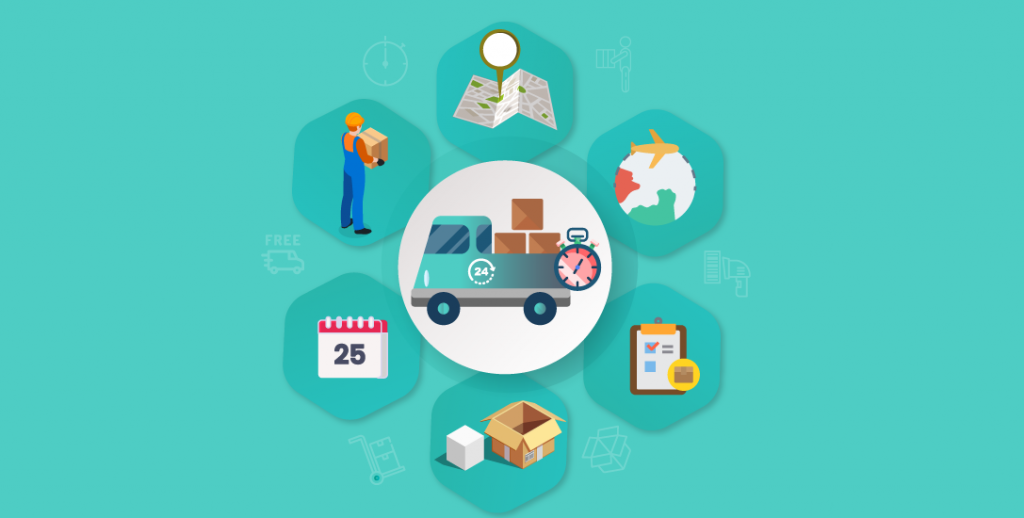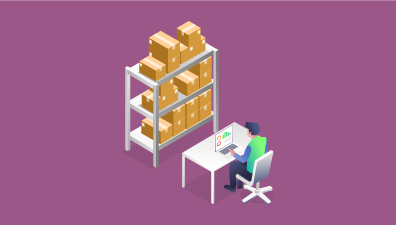What is inventory management? And how to improve it?
Some people want to have deep dive into inventory management definition and the methods to improve it because of its vital role. Inventory is the bridge between production and consumption. Sellers also want to increase inventory levels to respond to customer needs quickly.
The staff in charge of production and operations are also suitable for a large amount of inventory because it makes it easier to set up production plans. At the lowest level, money that lies in inventory will not be spent on other items. Because of that, inventory management can be treatable, not necessarily warehouse.
In this article, we explain clearly what inventory management is, how it works and suggest you some tips to manage inventory more effectively.
Table of Contents
1. What is Inventory Management?

It will be hard to precisely understand what inventory management is if you don’t have an exact understanding of inventory in the business. Inventories are manufactured goods that are preserved by an enterprise for final sale. In other words, inventories are stock items a company makes for sale and the ingredients that make up the products. Therefore, inventory is the link between co-production and selling products that are part of short-term assets, using a large proportion, playing an important role in the business production of the business.
Inventories that exist in a manufacturing company can be analyzed into three categories:
- Raw materials: that are sold or kept for future production, sent for processing and purchased on the way home.
- Semi-finished products: are products that are allowed to be used for production but are not yet finished and finished products are not kept in stock of finished products.
- Finished product: is a finished product after the manufacturing process.
To make sure that your inventory process works effectively, businesses should have optimal inventory management.
So, what is inventory management?
It is a planning method for determining when to place an order and the number of orders so that the cost of ordering and the storage costs can be optimally effective without causing production loss. This stock management entails creating a lead on raw materials, components, and finished goods, as well as keeping and processing such items within your business.
Inventory management is a must for any enterprise because it impacts the costs directly. An ineffective inventory process will lead to higher warehouse expenses, wasting and losing products and slow delivery that makes customers unsatisfied.
2. How does Inventory Management work?
Inventory management is a complicated process, especially in large organizations. In inventory management, products (in the form of materials or components) are brought to the receiving area in the warehouse and placed in particular stock areas.
Unlike larger businesses with more physical space, small companies will send products to stock areas, skipping receiving areas. In the wholesale industry, businesses make materials and components into finished products and straightly sent them to stock locations where they are kept prior to distribution or final customers. In inventory management, data is very important. Managers track and monitor products moving on the process based on data like lot numbers, serial numbers, costs, quantity and dates.
Inventory management helps revenue estimates. You will supply details for purchasing supplies and recognize sales trends that guide what inventory in future shipments should be ordered. If 90 bicycles will be demanded independently within the next month, then anything needed for bicycles in the dependent demand group needs to be ordered as well. The production of all 90 bicycles needs to be ordered in time.
This is, however, a simplistic balance. It is very seldom that only one item is made by a company. In the category of dependent demand, several more components would be made if the company had produced bikes, pumps, helmets, clothes, and shoes. In order to fulfill each sales item, these components also need to be ordered.
The items must be stored and arranged effectively in a warehouse once they have been purchased and shipped. The inventory control ensures that each item is tracked until it reaches the warehouse. It confirms revised inventory amounts and sends alerts when a stock falls. If a finished product is finished, inventory management shall store and monitor the product before it is sold.
When sold in the inventory management system, the status of the item is updated. The device will save the data for future sales projections when the final product is sold. If there was maybe a strong demand in the summer for bicycles and helmets for the previous two years, then this pattern will be recognized by a sales forecast and identified by a company for potential inventory purchases.
3. The inventory management benefits you should know
Avoid loss of goods
Goods loss occurs due to many reasons, which can be employee fraud, loss in the warehouse, or loss due to slippage. With effective inventory management, businesses will avoid wasting and losing goods. Thus, this is a notable inventory management importance.
Employee fraud is quite common in many stores. The fact that the employee gets used to many times not only causes other employees to suffer injustice, the store culture goes down but also causes damage to the shop owner. Therefore, transparent and scientific inventory management will minimize the habits of warehouse staff and sales staff.
In addition, there are losses due to price slippage, for many retail stores of technology goods such as electronics, home appliances, etc. goods are quickly out of fashion, replaced, and price slippage. Although usually supported with the best price by the supplier, the profit of the store is still affected by slippage.
Therefore, one of the inventory management benefits is that regular checking and comparison of the number of goods sold and the number of inventories will help the store to avoid significant losses, and to plan appropriate import of goods.
Cost savings
Goods/materials in stock for a long time that are damaged, worn out, expired, etc., must be destroyed because they cannot meet business needs. However, if the inventory is strictly, continuously, carefully planned, the store will avoid unnecessary waste.
The storage fee is usually not fixed, it depends on the quantity and size of the goods you store. The larger the inventory or the more products are too bulky, the store has to use many types of equipment and other costs such as electricity, water, labour, etc. Therefore, the cost of storage will increase.
Therefore, it is necessary to detect goods with large inventories early, goods that consume a lot of storage costs, to take measures to promptly release and circulate inventory, and save a lot of storage costs.
A large inventory is something no store owner wants. If capital is not profitable, it is “dead” capital. The large inventory causes a large amount of capital to be misused, wasted, or even thrown away.
For supermarkets/electronics stores/clothing stores, which import a lot of products that are difficult to sell, are not popular with customers, and are easily outdated, the possibility of selling losses or leaving is very large.
For a restaurant/cafe, managing a raw material warehouse is a crucial task. Good warehouse management makes it easy for restaurants to determine the cost of importing each day, determine the number of fresh ingredients used in the short term and the dry/frozen ingredients to store, the shelf life of the ingredients in the warehouse, which ingredients are about to expire, etc.
For restaurants, by estimating the number of dishes to be sold in a day/week/month, how many ingredients will be needed for each dish, how much of each ingredient is, the restaurant will have a clear plan for a purchase.
Increase sales for the store
The problem of raw materials and goods of the store is redundant, wasteful, but lacks revenue, affecting sales productivity, losing customers, and making the store unprofessional.
Effective inventory management will help you quickly know which items are selling well. It also helps you to import goods in time, or to offer promotions with low stock, large inventory in stock. Thus, the store will optimize revenue and profit.
Increase working capital efficiency
Working capital is the cash flow to maintain the business and reinvest the stores in the short term. Working capital comes from the own capital and sales of the store, spent for the purpose of importing goods, importing raw materials for 1 month or 1 quarter. Lack of working capital, the store will be immobilized because there is no money to continue its business.
Stocks – Including the products and materials in the warehouse is a factor in working capital. If the goods in stock are well circulated, it will reduce working capital for 1 month, 1 quarter and shorten the capital turnaround time.
This means a lot for many stores with a low budget.
- Reporting inventory of goods by week, day, and hour will help managers easily orient the timely import of goods, thereby adjusting working capital flows.
- The ability to quantify raw materials and quote the cost of each dish/drink for the restaurant/coffee shop model helps the store proactively raise the right amount of capital. The store only needs to multiply the cost of 1 dish/drink by the quantity that will be sold during the day/week/month.
- Warehouse management operations will indicate the type of goods that are in large stock so that the store owner can devise strategies to stimulate demand by reducing prices and promotions.
Instead of having to budget for 1 month or 1 quarter, store owners can better anticipate by fully exploiting the cash inflow.
>> Read more: Expert’s guide on 21 must-know inventory management techniques
Accurate reports
If you utilize cost of sale accounting, precise product reports result in accurate inventory cost figures, which are critical to the precision of numerous financial reports. The inventory links to the product’s asset value directly.
As a result, accurate cost values are important to your balance sheet, as well as your cost of sales and income statement. You will have accurate reports, analyze results precisely and give appropriate solutions and decisions.
4. All steps in the inventory management process

Plan and prepare
The first step in the inventory management process is planning and preparation. The management of inventory not only requires ensuring the complete and accurate quantity but also requires the administrator to ensure that the goods are imported and exported on time and according to the requirements of the goods. Therefore, planning for the import and export of goods is of great significance to businesses. Management needs to rely on the situation of the warehouse, the situation of production, and business to prepare the plan, personnel, and equipment accordingly.
Inventory of the warehouse
In this step, managers will check the inventory situation, the status of goods and raw materials to have a basis for planning accordingly. Inventory of goods also helps businesses understand the current status of products and materials to make decisions on consumption or timely supplementation.
Warehouse staff conduct a real inventory of inventory periodically and compare it with the accounting books to promptly adjust the matching data. Inventory data must be reported back to managers to manage inventory. Inventory should be done by two or more people and then collated to ensure accuracy. Today, the application of statistical management in the inventory control process will shorten inventory time and be more efficient.
Manage export and import
Inventory management includes the following tasks: purchase management, raw materials, production management, returned goods, warehouse transfer, etc.
In the past, import and export management was often done through books and papers. However, today, businesses can apply management software in inventory control processes or use barcode scanners to speed up the export and import management process.
Inventory management
Enterprises can apply manual methods or management software to check between the actual quantity of goods and the quantity on the accounting books. Inventory will help administrators to know which products are about to end, which are about to expire, which products are selling well that need to be supplemented, etc.
Determine
After checking the books, determining the number of goods actually in stock, the total amount of imports and exports at the end of the period, the accountant shall carry forward the balance at the end of this period to the beginning of the next period. At the same time, the accountant is in charge of archiving documents, importing, exporting, preparing, and printing inventory reports, reports in the period to submit to managers.
5. 7 common inventory management methods
Just-in-time (JIT)
JIT inventory management is a strategy for aligning material orders from suppliers with manufacturing schedules. Businesses hold as little stock as they can in order to avoid the expenses and hazards associated with maintaining a significant volume of stock.
ABC inventory analysis
This approach tries to find the inventory that is profitable for you by categorizing products into different tiers.
- Category A contains your most valued items, which contribute the most to your overall earnings.
- Category B includes products that lie midway between the highest and least valuable.
- Category C stores products that are important for overall profit but don’t mean significantly to the firm as a whole.
Bulk shipments
This method is based on the idea that buying in bulk is less expensive. The technique is ideal if a company is confident that its items will sell, but it might provide difficulties if demand unexpectedly shifts.
FIFO and LIFO
LIFO and FIFO are methods for calculating inventory costs. FIFO (First in, First Out) presupposes that older inventory is sold first. FIFO is an excellent method for keeping inventory current.
Last-in, first-out (LIFO) posits that fresher inventory is generally sold first. LIFO helps to keep inventories from spoiling.
Consignment
This method enables a consignor to deliver goods to a consignee, typically a retailer, without the consignee paying for the items in advance. The consignor retains ownership of the items, and the consignee pays for them only when they are sold.
Cross-docking
This method practically eliminates the requirement for inventory storage. Products are brought to a warehouse, where they are promptly processed and readied for transportation. They are often reloaded into other vehicles at the same facility and sent for rapid delivery.
Cycle counting
This method entails counting a limited amount of goods on a given day rather than doing a full stocktake. This approach allows your company to check proper stock levels in your inventory system on a routine basis.
>> Read more: 11 Inventory management Challenges, Problems and Solutions for it
6. How to improve Inventory Management?
Make sure everything is in its correct place
This is the key to helping shop owners effectively manage their inventory. Disorganization in the way the goods are sorted can interfere with the refilling process and make it more difficult for your employees to control and pick up the goods.
If everything is in place, you will easily find out which goods have disappeared, helping to reduce damage and theft.
In addition, placing the goods in the right position helps you easily control which goods are out of stock, need to import more, or which are too much in stock and need to be liquidated.
Always do a good job of preventing damage
This means you need to be in control at all times to prevent any possible loss, affecting your business as well as causing damage or loss to your store.
The import and export of goods must be monitored in detail by a professional department. This is seen as the only way to prevent loss and support effective inventory management.
Invest in inventory management methods training
Investing in effective inventory management training should start as soon as possible, the training should be detailed to help your employees get the most accurate capture.
It should be noted that training procedures need to be closely linked with implementation for the best effect.
Tight connection between departments
The unified workflow between departments always makes your business much easier and more efficient.
Goods supply and demand need to be planned and studied before being imported in large quantities.
Customer behavior will always determine the destiny of a product, so tracking trends is a must in order to grow a business.
Optimize your import process
For small retail stores, optimizing your inventory is the key to efficient inventory management.
Therefore, if you can eliminate errors in this step, it will help you greatly reduce problems arising in the next process.
In addition, monthly and quarterly inventory statistics will help a lot for running your business, especially if you don’t have too many Stock Keeping Unit (SKU) codes.
Final words
With our explanation, you properly understand more about inventory management definition and how it works. It can be simplified by many systems and procedures and best handled by dedicated inventory management software. Different management systems perform best for different businesses, depending on the size of a company and the extent of its inventory. In any case, it is critical that your biggest asset inventory is managed by the most efficient method.
In addition to applying some tips and methods, businesses should use effective inventory software to assist them in managing their products in the warehouse. Among various inventory management systems, Odoo is one of the greatest choices for any enterprise due to its holistic solution, reasonable price and simple installation. You don’t have to integrate any software to operate all sectors in your business because Odoo can do it for you.
If you want to find a third-party development company to help you apply Odoo to your organization, you can connect with Magenest. Being a silver partner of Odoo and accomplished various projects, Magenest will give you the best solution for your inventory management.
Don’t hesitate and talk to us now!















